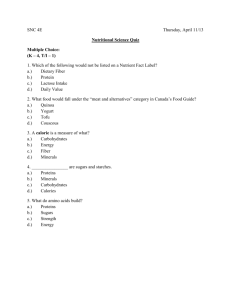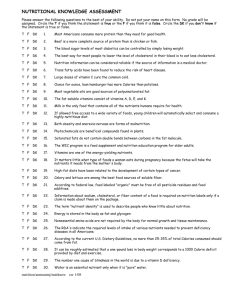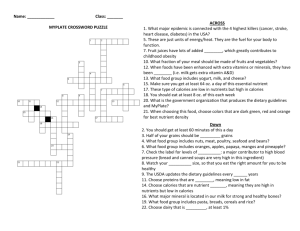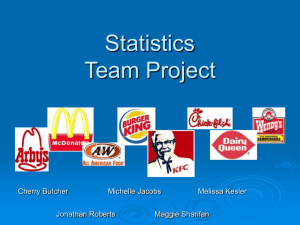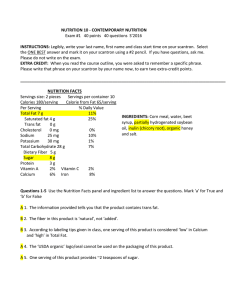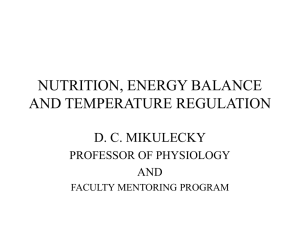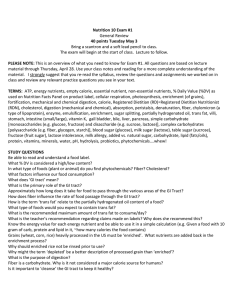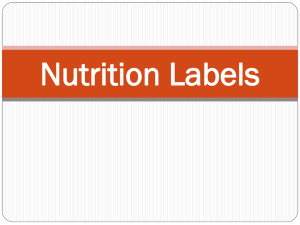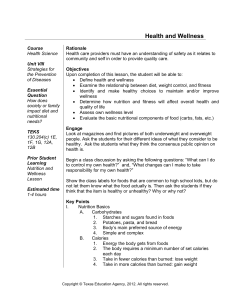Exam 1 Review 40 question exam-40 points. Please bring a
advertisement
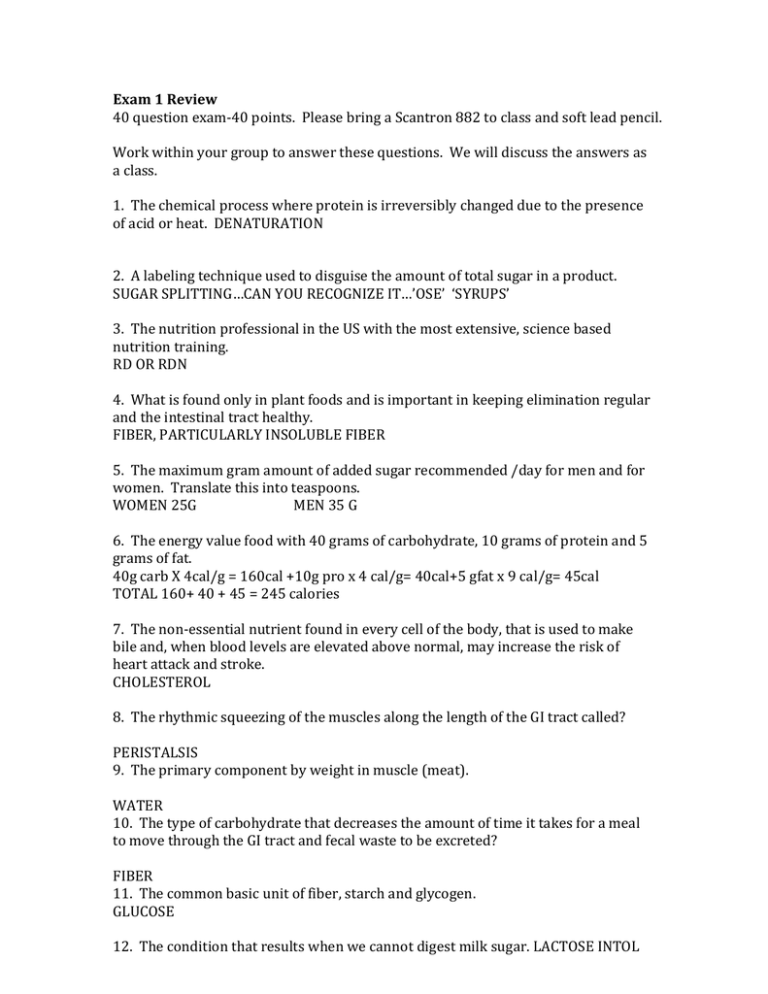
Exam 1 Review 40 question exam-40 points. Please bring a Scantron 882 to class and soft lead pencil. Work within your group to answer these questions. We will discuss the answers as a class. 1. The chemical process where protein is irreversibly changed due to the presence of acid or heat. DENATURATION 2. A labeling technique used to disguise the amount of total sugar in a product. SUGAR SPLITTING…CAN YOU RECOGNIZE IT…’OSE’ ‘SYRUPS’ 3. The nutrition professional in the US with the most extensive, science based nutrition training. RD OR RDN 4. What is found only in plant foods and is important in keeping elimination regular and the intestinal tract healthy. FIBER, PARTICULARLY INSOLUBLE FIBER 5. The maximum gram amount of added sugar recommended /day for men and for women. Translate this into teaspoons. WOMEN 25G MEN 35 G 6. The energy value food with 40 grams of carbohydrate, 10 grams of protein and 5 grams of fat. 40g carb X 4cal/g = 160cal +10g pro x 4 cal/g= 40cal+5 gfat x 9 cal/g= 45cal TOTAL 160+ 40 + 45 = 245 calories 7. The non-essential nutrient found in every cell of the body, that is used to make bile and, when blood levels are elevated above normal, may increase the risk of heart attack and stroke. CHOLESTEROL 8. The rhythmic squeezing of the muscles along the length of the GI tract called? PERISTALSIS 9. The primary component by weight in muscle (meat). WATER 10. The type of carbohydrate that decreases the amount of time it takes for a meal to move through the GI tract and fecal waste to be excreted? FIBER 11. The common basic unit of fiber, starch and glycogen. GLUCOSE 12. The condition that results when we cannot digest milk sugar. LACTOSE INTOL 13. The condition that results when a foreign protein (e.g. from peanuts, fish, egg, pollen, etc.) gets into the blood. ALLERGY 14. What is the term to describe a food when it has a lot of calories, but almost no nutrients? Give an example. EMPTY CALORIES 15. A food that contains partially hydrogenated oil on its ingredient list can be assumed to contain what unhealthy type of fat? TRANS FAT GOAL: < 2G/DAY 16. The percent Daily Value of a nutrient in a food that is considered high? Low? HIGH>20% LOW < 5% 17. Where healthy bacteria live in the GI tract and make vitamin K ? LARGE INTESTINE...they are called ‘probiotics’. Some foods we eat encourage their growth, they are called ‘prebiotics’ 18. The process where solar energy is transferred into the organic nutrients of food. PHOTOSYNTHESIS 19. The reason your instructor asked you to think of the word ‘depleted’ when you see the word ‘enriched’ on an ingredient list? BECAUSE THE PROCESSED GRAIN, EVEN WITH NUTRIENTS ADDED BACK (enriched), HAS LESS NUTRIENTS THAN PRIOR TO PROCESSING 20. The essential nutrient for which we have the most acute need. WATER 21. This offered us a survival advantage by helping us to better digest fat when, on occasion, we were exposed to a large amount of it in our diet. BILE 22. The form in which dietary carbohydrates (proteins/lipids) are absorbed into the blood. GLUCOSE/AMINO AICDS/ CHYLOMICRONS 23. Why fiber is not a good energy source for humans. WE CANNOT COMPLETELY DIGEST IT TO ITS GLUCOSE BUILIDING BLOCKS, SO IT CANNOT BE ABSORBED. INSTEAD IT IS MOVED ALONG TO THE LI WHERE SOME BACTERIA FEED ON IT AND THE REST IS EXCRETED 24. A non-preferred body fuel that is unique because of its nitrogen content. AMINO ACIDS 25. The most versatile, clean burning fuel for the body. GLUCOSE 26. The energy nutrient that should provide us with most of our calories every day. CARBOHYDRATE 27. A name for simple sugars that have calories, but little other nutrient content and that we typically use with food to make it sweeter. ADDED SUGARS …typically end in ‘ose’ and/or are listed as a syrup 28. The ultimate source of energy that is transferred into food energy. SOLAR ENERGY 29. The major source of the dry weight of most all plants (includes fruit, veg, grain) CARBON FROM CARBON DIOXIDE 30. Give three simple recommendations to your friend who is trying to learn how to decipher a food label. READ INGREDIENT LIST (want ingreds you recognize and few of them) READ NUTRITION FACTS (use serve size you actually eat, look for hi/low DV item) IGNORE ALL PRODUCT CLAIMS (some are OK, but too many are bogus) Nutrition Facts Serving Size 1 container (200 g) Calories 150 Fat calories 35 *Percent Daily Value (DV) are based on a 2000 calorie diet. Amount/serving Total fat 4g sat fat 3g trans 0g Cholesterol 10 mg Sodium 66 mg Total Carb 8g fiber 0g sugar 5g Protein 20g vitamin A Calcium %DV* 6% 15% 3% 3% 3% 0% 2% 20% vitamin C Iron 0% 0% Ingredients: grade A pasteurized skimmed milk and cream, live active yogurt cultures (L. Bulgaricus, S. Thermophilus, L. Acidophilus, Bifidus, L. Casei) 1. Is the sugar in this added, natural or both? 2. Which nutrients are contained in a high amount in this product? Low amount? Calcium high, A, C, iron, fiber low -- not good: Cholesterol/sodium low -- good 3. Is there any trans fat in this product? 4. Given: your protein need is about half your weight in pounds. Does this product seem to be a good source of protein or not? Yes, it seems high 200# needs ~ 100 g 20 grams in 15 cal is s good deal. Probably eating 2500 cal/day This has 150 cal or ~5-6% of cal 5. Would you recommend this product to someone with lactose intolerance? Protein allergy? Nope…too much milk in it. They might be OK with the lactose, but wouldn’t take a chance at all if someone has a milk allergy 6. Would you consider this a real, whole food? Yes 7. Where do you think the sodium comes from in this food? The milk

